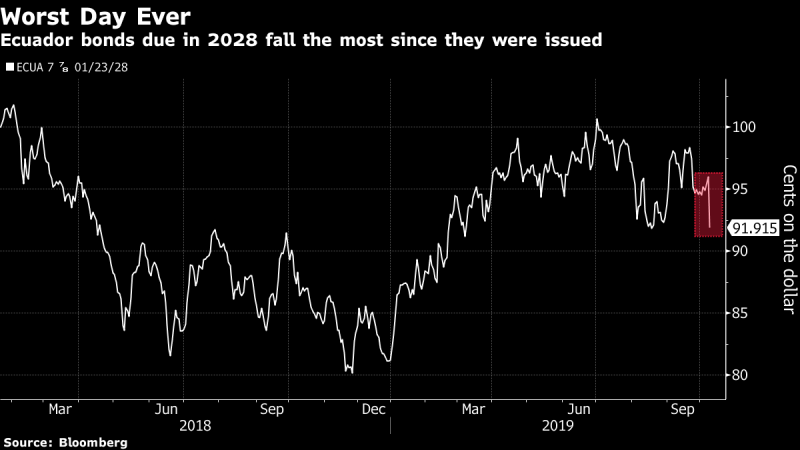
(Bloomberg) — With Ecuadorian protesters infuriated by rising fuel prices occupying government offices and oil fields, the president and his administration fled the capital, warning of a coup.
In a national address late Monday, President Lenin Moreno said he had moved the executive branch from Quito to the port city of Guayaquil due to security threats. The president said that allies of his predecessor Rafael Correa had infiltrated protests against increases in fuel prices in a bid to topple his government.
“They are the ones behind this coup attempt,” Moreno said, without providing evidence. “The looting, vandalism and the violence show that here there is an organized political intention to destabilize the government and break the democratic order.”
The government of the South American nation of about 16.5 million decamped after another night in a week of unrest. Protesters in Quito damaged Ecuador’s congressional building and violently entered the comptroller general’s office across the street. On Monday, rioters also attacked an oil production facility, a major dairy and dozens of rose plantations. They burned police and military vehicles as security forces struggled to contain the violence.
“When I read that Moreno had left, I felt that we’ve been left alone, who is going to defend us?” said Susana Vega, a Spanish teacher in Quito. “This isn’t a strike, this is something much more sinister.”
Correa, who is living in Belgium as he fights charges that he had a political opponent kidnapped, said in a Twitter post that Moreno “is finished” and called for elections.
“There is no coup-mongering here,” he said in a video posted to the site. “Conflicts in democracy are resolved at polls, and that’s precisely what we’re asking for.”
The tumult began when the government eliminated subsidies on gasoline and diesel, a move welcomed by the International Monetary Fund and debt-rating companies including Moody’s Investors Service. Moreno reiterated Monday night that he wouldn’t reinstate the subsidies, which had been in place since the 1970s and which were costing the government close to $1.4 billion a year. Observers didn’t take that as the final word.
“There is a non-zero risk that Moreno knuckles under pressure and rolls back the subsidy cuts,” Edwin Gutierrez, London-based head of emerging-market sovereign debt at Aberdeen Asset Management, wrote in a written reply to questions. “Given the violence and protests, that risk has clearly risen.”
The nation’s dollar bonds due in 2028 fell 3.6 cents to 93 cents on the dollar, the biggest drop since they were sold in January 2018, sending yields up 0.65 percentage point.
Ecuador, a producer of commodities such as oil, copper, shrimp and bananas, has been engulfed by the protests. In the Amazon region, demonstrators entered facilities of the Sacha oilfield, prompting authorities to shut down production and causing the loss of 70,000 barrels of Ecuador’s output of 550,000 barrels per day. The pipeline known as SOTE was halted for more than two hours after sabteurs broke into its installations Monday night, the Energy Ministry said in a statement.
Read More: Ecuador’s Exit Is Another Blow for OPEC
Central regions were cut off from television and radio service as demonstrators seized repeater antennas. Indigenous communities blocked numerous main roads in the Andean region, home to half the nation’s residents. Cuenca, the third-largest city, is receiving supplies by air.
In Quito, traffic on a cool, rainy Tuesday morning was unusually light and the city was oddly quiet. Schools were closed, and many evening events canceled. The unprecedented scale of the unrest, including rioting and looting, has worried many residents who stocked up on goods, emptying supermarket shelves. Police and armed forces are escorting supplies to stores as numerous important roads remain cut off by protesting indigenous communities.
The crisis marks a turning point for Moreno, who was expected to lead as a leftist but has governed as a maverick.
When he took office in 2017, many assumed he’d continue to lead the country along the repressive and spendthrift path forged by Correa, his former mentor, who held office for a decade. Correa is responsible for a string of ill-considered public works projects, including power plants, refineries, pipelines, airport terminals and a railway. They’ve been dogged by cost overruns, construction and design flaws and accusations of corruption. Correa defaulted on $3.2 billion in bonds for political reasons.
Moreno has pushed economic and political reform, fought corruption and tried to restore an independent press and judiciary. He championed term limits for elected officials and helped judicial reformers replace a constitutional court so discredited that several members were under suspicion of money laundering. He remade economic policy, which led to a decrease in yields on Ecuadorian bonds and a $4.2 billion agreement with the IMF to restore dollar reserves and stabilize public debt — in part by removing the fuel subsidy.
“The stakes are high,” said Siobhan Morden, the head of Latin America fixed income strategy at Amherst Pierpont Securities in New York. “If President Moreno reinstates the subsidies, then the IMF program is at risk.”
(Adds comment from Quito resident in fifth paragraph)
To contact the reporters on this story: Stephan Kueffner in Quito at [email protected];Aline Oyamada in Sao Paulo at [email protected]
To contact the editors responsible for this story: Juan Pablo Spinetto at [email protected], Stephen Merelman, Bob Ivry
<p class="canvas-atom canvas-text Mb(1.0em) Mb(0)–sm Mt(0.8em)–sm" type="text" content="For more articles like this, please visit us at bloomberg.com” data-reactid=”43″>For more articles like this, please visit us at bloomberg.com
©2019 Bloomberg L.P.











Add Comment